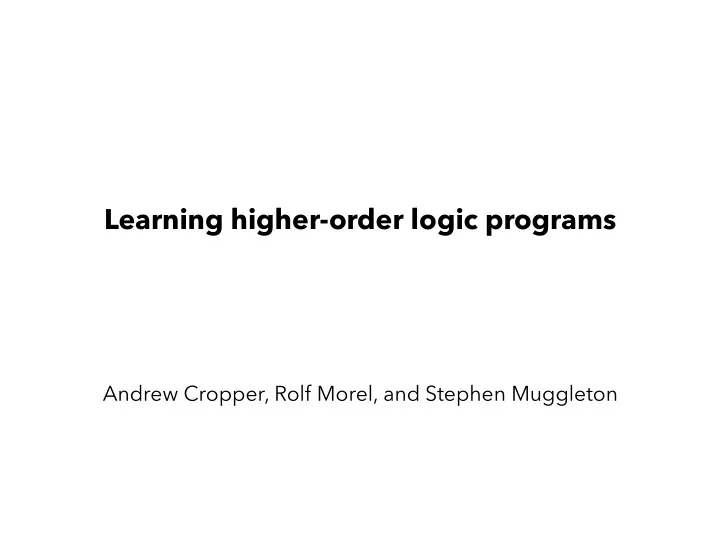

Learning higher-order logic programs Andrew Cropper, Rolf Morel, and Stephen Muggleton
Program induction/synthesis Examples Learner Background knowledge
Program induction/synthesis Examples Learner Computer program Background knowledge
Examples input output dog g sheep p chicken ?
Examples Background knowledge head input output tail dog g empty sheep p chicken ?
Examples Background knowledge head input output tail dog g empty sheep p chicken ? def f(a): t = tail(a) if empty(t): return head(a) return f(t)
Examples Background knowledge head input output tail dog g empty sheep p chicken n def f(a): t = tail(a) if empty(t): return head(a) return f(t)
Examples Background knowledge head input output tail dog g empty sheep p chicken n f(A,B):-tail(A,C),empty(C),head(A,B). f(A,B):-tail(A,C),f(C,B).
input output dbu cat eph dog hpptf ?
input output dbu cat eph dog hpptf goose
base case f(A,B):- empty(A), empty(B). f(A,B):- head(A,C), char_to_int(C,D), inductive case prec(D,E), int_to_char(E,F), head(B,F), tail(A,G), tail(B,H), f(G,H).
f(A,B):- f1(A,B):- empty(A), char_to_int(A,C), empty(B). prec(C,D), f(A,B):- int_to_char(D,B). head(A,C), f1(C,F), head(B,F), cool stuff tail(A,G), tail(B,H), f(G,H). list manipulation
f(A,B):- f1(A,B):- empty(A), char_to_int(A,C), empty(B). prec(C,D), f(A,B):- int_to_char(D,B). head(A,C), f1(C,F), head(B,F), tail(A,G), tail(B,H), f(G,H).
Idea Learn higher-order programs
map([],[],_F). map([A|As],[B|Bs],F):- call(F,A,B), map(As,Bs,F).
f(A,B):- f1(A,B):- map(A,B,f1). char_to_int(A,C), prec(C,D), int_to_char(D,B).
f(A,B):- f1(A,B):- map(A,B,f1). char_to_int(A,C), prec(C,D), int_to_char(D,B). From 12 to 6 literals
Why? Search complexity is b n b is the number of background relations n is the size of the program Idea: increase branching to reduce depth
Fragment Complexity First-order 6 12 = 2,176,782,336
Fragment Complexity First-order 6 12 = 2,176,782,336 Higher-order 7 6 = 117,649 +1 because of map
Fragment Complexity First-order 6 12 = 2,176,782,336 Higher-order 7 6 = 117,649 Higher-order* 4 6 = 4,096 If we do not give head, tail, empty
How? Extend Metagol [Cropper and Muggleton, 2016]
Metagol Proves examples using a Prolog meta-interpreter Extracts a logic program from the proof Uses metarules to guide the search
Metarule P (A,B) ← Q (A,C), R (C,B) P , Q , and R are second-order variables A , B , and C are first-order variables
Examples input output 1 3 2 4 3 ?
Examples Background knowledge succ/2 input output Metarule 1 3 P (A,B) ← Q (A,C), R (C,B) 2 4 3 ?
Examples Background knowledge succ/2 input output Metarule 1 3 P (A,B) ← Q (A,C), R (C,B) 2 4 3 ? P/target, Q/succ, R/succ target (A,B) ← succ (A,C), succ (C,B)
Examples Background knowledge succ/2 input output Metarule 1 3 P (A,B) ← Q (A,C), R (C,B) 2 4 3 5 P/target, Q/succ, R/succ target (A,B) ← succ (A,C), succ (C,B)
Examples input output [1,2,3] [c,d,e] [2,3,4] ? [3,4,5] ?
Background knowledge Examples succ/2 int_to_char/2 input output map/3 [1,2,3] [c,d,e] [2,3,4] ? Metarules [3,4,5] ? P (A,B) ← Q (A,C), R (C,B) P (A,B) ← Q (A,B, R )
negated example (i.e. a goal) ← f([1,2,3],[c,d,e])
metarule ← f([1,2,3],[c,d,e]) P (A,B) ← Q (A,B, R )
← f([1,2,3],[c,d,e]) P (A,B) ← Q (A,B, R ) resolution {P/f}
← f([1,2,3],[c,d,e]) P (A,B) ← Q (A,B, R ) ← Q ([1,2,3],[c,d,e], R ) new goal
← Q ([1,2,3],[c,d,e], R )
succ/2 int_to_char/2 ← Q ([1,2,3],[c,d,e], R ) map/3
map/3 ← Q ([1,2,3],[c,d,e], R ) resolution {Q/map}
map/3 ← Q ([1,2,3],[c,d,e], R ) ← map([1,2,3],[c,d,e], R )
succ/2 int_to_char/2 ← map([1,2,3],[c,d,e], R ) map/3
succ/2 int_to_char/2 ← map([1,2,3],[c,d,e], R ) map/3 ← map([1,2,3],[c,d,e],succ) ← map([1,2,3],[c,d,e],int_to_char)
Metagol solution f(A,B):-f1(A,C),f3(C,B) f1(A,B):-f2(A,C),f2(C,B). f2(A,B):-map(A,B,succ). f3(A,B):-map(A,B,int_to_char).
Metagol unfolded solution f(A,B):- map(A,C,succ). map(C,D,succ). map(D,B,int_to_char).
Metagol HO Allows interpreted background knowledge ibk( [map,[A|As],[B|Bs],F], % head [[F,A,B],[map,As,Bs,F]] % body ).
BK Examples succ/2 int_to_char/2 input output [1,2,3] [c,d,e] Interpreted BK [2,3,4] ? map/3 [3,4,5] ? Metarules P (A,B) ← Q (A,C), R (C,B) P (A,B) ← Q (A,B, R )
negated example (i.e. a goal) ← f([1,2,3],[c,d,e])
metarule ← f([1,2,3],[c,d,e]) P (A,B) ← Q (A,B, R )
← f([1,2,3],[c,d,e]) P (A,B) ← Q (A,B, R ) resolution {P/f}
← f([1,2,3],[c,d,e]) P (A,B) ← Q (A,B, R ) ← Q ([1,2,3],[c,d,e], R ) new goal
← Q ([1,2,3],[c,d,e], R )
interpreted BK ← Q ([1,2,3],[c,d,e], R ) map([A|As],[B|Bs], R ) ← …
← Q ([1,2,3],[c,d,e], R ) map([A|As],[B|Bs], R ) ← … resolution {Q/map}
← Q ([1,2,3],[c,d,e], R ) map([A|As],[B|Bs], R ) ← … ← R (1,c), R (2,d), R (3,e) map decomposes goal into subgoals
← R (1,c), R (2,d), R (3,e)
metarule ← R (1,c), R (2,d), R (3,e) S (A,B) ← T (A,C), U (C,B) resolution {R/S}
← R (1,c), R (2,d), R (3,e) S (A,B) ← T (A,C), U (C,B) ← T (1,C1), U (C1,c), T (2,C2), U (C2,d), T (3,C3), U (C3,e) decomposes problem again
← R (1,c), R (2,d), R (3,e) S (A,B) ← T (A,C), U (C,B) ← T (1,C1), U (C1,c), T (2,C2), U (C2,d), T (3,C3), U (C3,e) and the proof continues …
Metagol HO solution f(A,B):-map(A,B,f1). f1(A,B):-succ(A,C),f2(C,B). f2(A,B):-succ(A,C),int_to_char(C,B).
Metagol HO unfolded solution invented f(A,B):- map(A,B,f1). f1(A,B):- succ(A,C), succ(C,D), int_to_char(D,B).
Decryption example input output dbu cat eph dog hpptf ?
Metagol f(A,B):-f1(A,B),f5(A,B). f1(A,B):-head(A,C),f2(C,B). f2(A,B):-head(B,C),f3(A,C). f3(A,B):-char_to_int(A,C),f4(C,B). f4(A,B):-prec(A,C),int_to_char(C,B), f5(A,B):-tail(A,C),f6(C,B). f6(A,B):-tail(B,C),f(A,C). 7 clauses and 21 literals
Metagol HO f(A,B):-map(A,B,f1). f1(A,B):-char_to_int(A,C),f2(C,B). f2(A,B):-prec(A,C),int_to_char(C,B). 3 clauses and 8 literals
Does it help in practice? Q. Can learning higher-order programs improve learning performance?
Robot waiter
Chess
Droplasts Input Output [alice,bob,charlie] [alic,bo,charli] [inductive,logic,programming] [inductiv,logi,programmin] [ferrara,orleans,london,kyoto] [ferrar,orlean,londo,kyot]
Metagol HO solution f(A,B):-map(A,B,f1). f1(A,B):-f2(A,C),f3(C,B). f2(A,B):-f3(A,C),tail(C,B). f3(A,B):-reduceback(A,B,concat).
Metagol HO unfolded solution invented droplast f(A,B):-map(A,B, f1 ). f1 (A,B):- f2 (A,C),tail(C,D), f2 (D,B). f2 (A,B):-reduceback(A,B,concat). invented reverse
Double droplasts Input Output [alice,bob,charlie] [alic,bo] [inductive,logic,programming] [inductiv,logi] [ferrara,orleans,london,kyoto] [ferrar,orlean,londo]
Metagol HO solution f(A,B):-f1(A,C),f2(C,B). f1(A,B):-map(A,B,f2). f2(A,B):-f3(A,C),f4(C,B). f3(A,B):-f4(A,C),tail(C,B). f4(A,B):-reduceback(A,B,concat).
Metagol HO unfolded solution uses f1 as a predicate symbol uses f1 as a term f(A,B):-map(A,C, f1 ), f1 (C,B). f1 (A,B):- f2 (A,C),tail(C,D), f2 (D,B). f2 (A,B):-reduceback(A,B,concat).
Conclusions Inducing higher-order programs can reduce program size and sample complexity and improve learning performance Can decompose problems through predicate invention
Limitations Inefficient search Which metarules? Which higher-order definitions?
Thank you Cropper, A., Morel, R., and Muggleton, S. Learning higher-order logic programs. Machine Learning. 2019. Metagol system. https://github.com/metagol/metagol
Recommend
More recommend